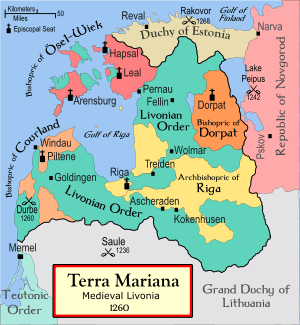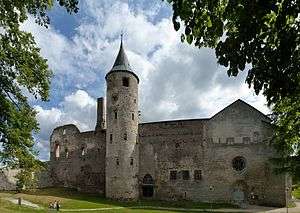Bishopric of Ösel–Wiek
| Bishopric of Ösel–Wiek | ||||||||||||||
| Bisdom Ösel–Wiek (nds) Ecclesia Osiliensis (la) | ||||||||||||||
| Prince-Bishopric of Terra Mariana | ||||||||||||||
| ||||||||||||||
|
| ||||||||||||||
 The Bishopric of Ösel–Wiek, shown (red, upper left, across the Estonian mainland and the islands of Dagö (Hiiumaa) and Ösel (Saaremaa)) within the Livonian Confederation, 1260 | ||||||||||||||
| Capital | Leal (Lihula) Perona (Vana-Pärnu) Hapsal (Haapsalu) Arensburg (Kuressaare) | |||||||||||||
| Languages | Low German, Estonian | |||||||||||||
| Religion | Roman Catholicism | |||||||||||||
| Government | Principality | |||||||||||||
| Prince-Bishop | ||||||||||||||
| • | 1228–1229 | Gottfried | ||||||||||||
| • | 1542–1560 | Johannes V von Münchhausen | ||||||||||||
| Historical era | Middle Ages | |||||||||||||
| • | Established | October 1, 1228 | ||||||||||||
| • | Sold to Denmark | 1560 | ||||||||||||
| ||||||||||||||
The Bishopric of Ösel–Wiek (Estonian: Saare-Lääne piiskopkond; German: Bistum Ösel–Wiek; Low German: Bisdom Ösel–Wiek; contemporary Latin: Ecclesia Osiliensis) was a semi-independent Roman Catholic prince-bishopric in what is now Saare, Hiiu and Lääne counties of Estonia.
History
The bishopric was created as a state of Holy Roman Empire on 1 October 1228, by Henry, King of the Romans. One of the five members of the Livonian Confederation, the seat of the bishop was successively Leal (Lihula), Perona (Vana-Pärnu), Hapsal (Haapsalu), and the castle of Arensburg (Kuressaare) on the island of Ösel (Saaremaa); the cathedral and chapter remained in Hapsal. Administratively the state was divided into two bailiwicks (advocaciae, Vogteien). The bishop was also the lord of the Teutonic Order over its fiefs on the bishopric's territory.
The principality ceased to exist in 1560 when its last prince-bishop, Johannes V von Münchhausen, sold it to Denmark. King Frederick II of Denmark's brother Magnus, Duke of Holstein, was elected bishop on 13 May 1560, despite being Lutheran. Denmark ceded Wiek (Lääne County) to the Polish-Lithuanian Commonwealth in exchange for parts of Ösel belonging to the Livonian Order. Later Ösel became a Danish possession.
Bishops and Prince-Bishops
- Gottfried, 1228–1229, still living in 1257
- Vacant
- Heinrich I, 1234–1260
- Hermann I de Becheshovede (Buxhoevden), 1262–1285?
- Heinrich II, 1290–1294
- Vacant
- Konrad I 1297?–1307?
- Vacant
- Hartung, 1310–1321
- Jakob, 1322–1337
- Hermann II Osenbrügge (de Osenbrygge), 1338–1362
- Konrad II, 1363–1374
- Heinrich III, 1374–1381
- Vacant
- Winrich von Kniprode, 1385–1419
- Caspar Schuwenflug, 1420–1423
- Christian Kuband, 1423–1432
- Johannes I Schutte, 1432–1438
- Johannes II Creul (Kreuwel), 1439 de jure – 1457 (de facto since 1449 in Wiek as the younger Bishop) with
- Ludolf Grove, 1449–1458 (de facto 1439, since 1449 in Saaremaa and Dagö as the older Bishop)
- Jodokus Hoenstein, 1458–1471
- Peter Wetberg, 1471–1491
- Johannes III Orgas (Orgies), 1492–1515
- Johannes IV Kyvel (Kievel), 1515–1527
- Georg von Tiesenhausen, 1528–1530
- Reinhold von Buxhoeveden, 1532–1541, died 1557
- Johannes V von Münchhausen, 1542–1560
- Magnus of Livonia (also Prince of Denmark and Duke of Holstein), 1560–1572 (Protestant bishop, died 1583)

